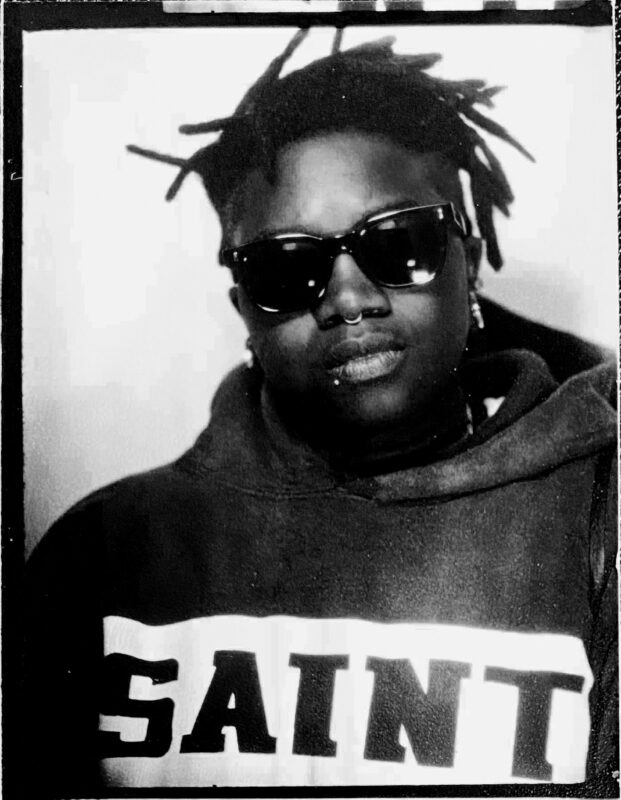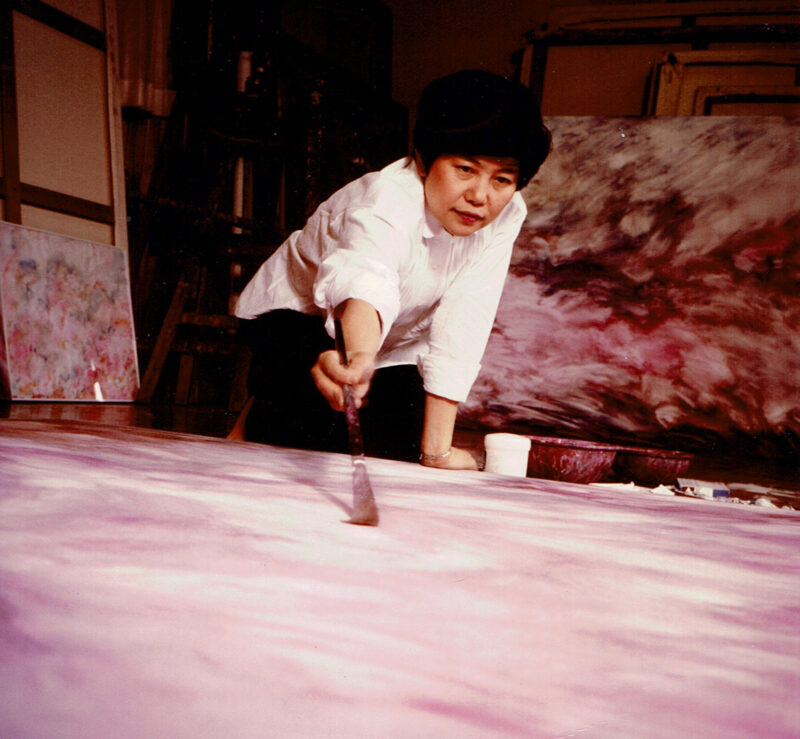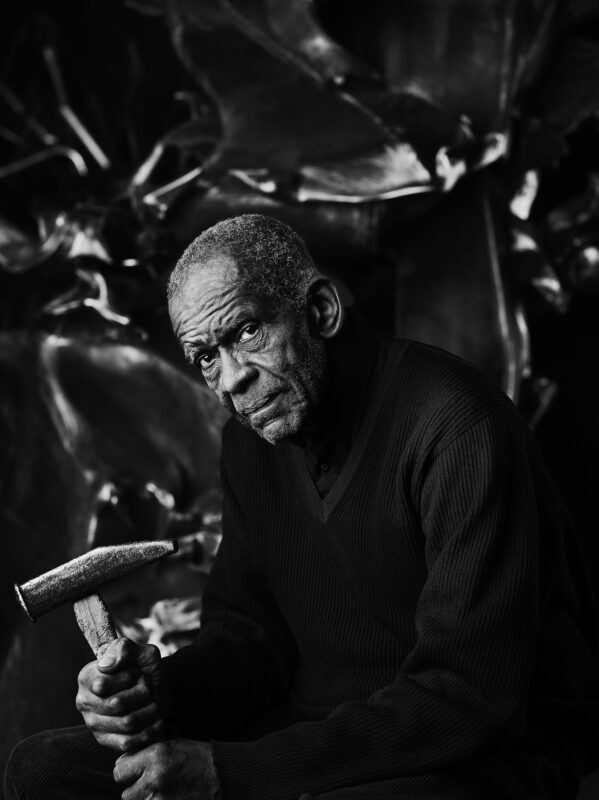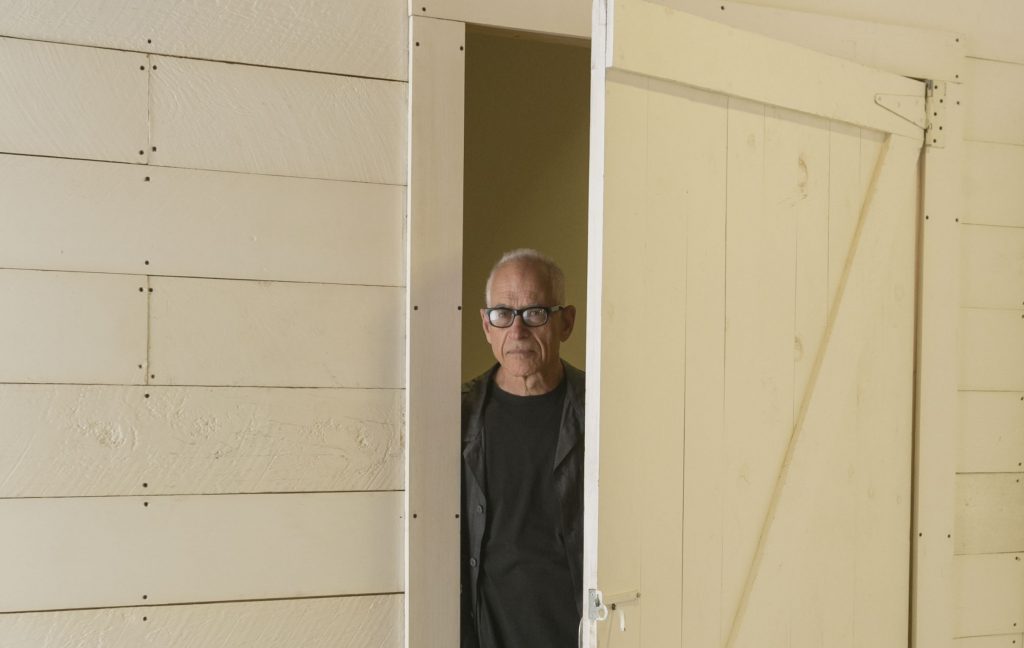
Haim Steinbach © Palazzo Grassi, photo by Matteo De Fina
In 1979 you took part in an exhibition at Artists Space where you exhibited your work Display #7 which has been called seminal/ very important, why is it seen as so important?
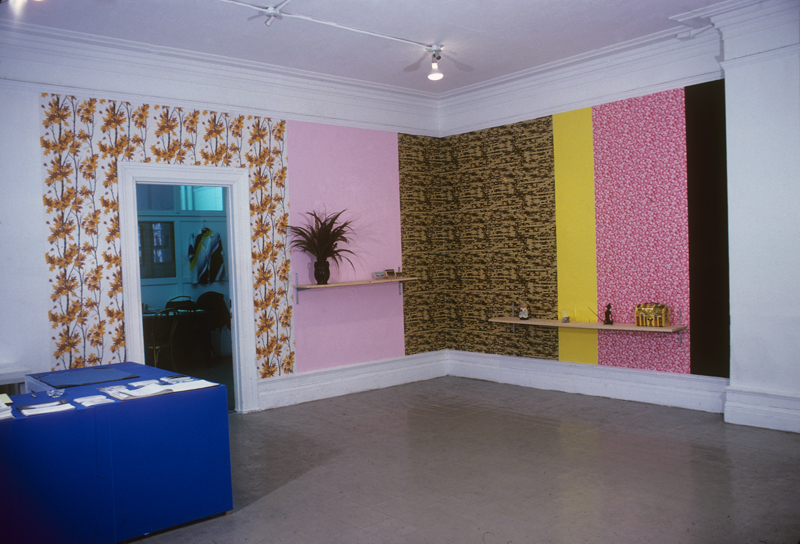
Installation view of Haim Steinbach’s exhibition, Display #7, Artists Space, 1979
I showed one work in one space – there where other artists showing and they also showed one work.
I exhibited Display #7 – it was important because:
It was a concept that generated a new historical movement in contemporary art.
We have a history of artists taking objects and doing things with objects but usually they alter them. Such as Marchel Duchamp, but he called these objects Ready Made, by calling them Ready Made he christened them with his own name and they become Duchamp objects. Now art historians and art journalists refer to all objects as a Ready Made. This is totally incorrect because the name is really specific to Duchamp’s work and every object is not a Ready Made as he used objects in a specific way. Most of the objects Duchamp used in his work he altered by writing on them, or signing them or adding them to other objects in a sense he was working like a Dadaist or ?Surrealist.
What I do is very different because I don’t alter the object in any kinda way. I make sure not to ‘put’ the object in any particular way that alters it’s meaning in the sense – ‘It’s meaning is inherent in what it is in itself, not because I glued it to another object or something like that. I simple place the object on a shelf/ surface in a normative way meaning: the way that people use objects. I don’t draw them , I don’t alter them. They are basically found objects or already existing objects, I just make arrangements of them. That is something everybody does, people arrange objects in their houses, whether they are more self conscience about it, how they place it in living room or less self conscience how they place it in the bathroom usually there is a reason/s how they place them based on collective social reasons/norms. Take a nail and hammer the soap into the wall by the side of the faucet as they are gonna use it to wash their hands – So there are logical places for the objects.
A shelf is a logical place to put things on. So Display Shelf 7 was a situation in which I just placed the shelf against the wall and arranged objects – something so simple. I did something else – I raised questions about the wall, because the wall in our contemporary culture is usually ok if it is white but it is not ok if you put a pattern on it, then it means you are saying something about your culture and so on.
But white is already saying something about your culture – and therefore white is a social, cultural thing it is an object that has its on raison d’être. So what did I do when I put the shelf on the wall? Well initially it was a white wall. What about if I put a strip of black going from the ceiling to the floor and divide the wall into strips, oh well if I was going to do that I should add another strip that is patterned and so on. I arranged some strips and you have a kinda relativity that raises a question about the pattern. So when the object was on the shelf it was in front of a kind of pattern, one solid colour and so on this was Display #7. Furthermore the objects in Display #7 where objects I borrowed from friends and family. I approached them and asked them – ‘Would you give me this object’ or ‘can I borrow the object’ or ‘I like this object in your house, can I take it?’and they let me borrow/take. So it was a kinda collective activity it was interactive. Coming from outside the gallery into the gallery from a community of people who I already had a relationship with & this brings in another kinda idea of contingency and relations, doing that in 1979 – no one was doing that – no one.
After that exhibition did you give the objects back?
I gave all the objects back except for a couple of objects where the participant said ‘ Oh Haim you can have it’ So it only existed for the exhibition except for a couple of objects.
For this exhibition ‘Jaws’ at White Cube how did you get the objects that are on the shelves?
Kongs– I begun encompassing them into my work in 2002 initially as another object that I found which I put together with other objects, but then the Kong’s became a marker of time and they almost became as ingredient of my work. & they have shown up more often now since 2007. So thats my kinda object , now the fins this is the first time they came into my work and it’s possible they will reappear more often. I have seen them often , I have a friend who has a surfing store in my neighbourhood Brooklyn.
I’ve seen them, I like them, I didn’t think about them much but they registered with me. Some things register with me and don’t stay long and others do.
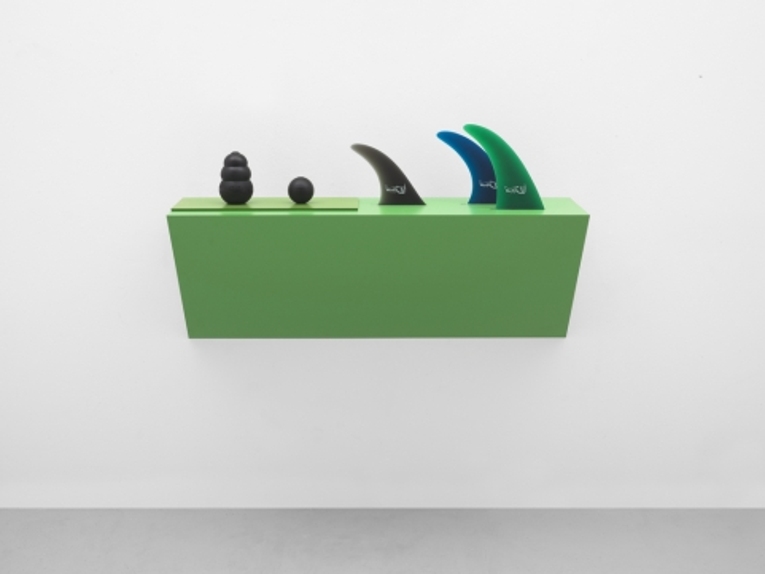
Kong, rubber ball, fins Haim Steinbach.
And then they resurfaced (the Fins) – and at some point I thought : ‘What about I start making a work and put fins in the work. So they came about this way and this is the first time I have incorporated them in my works. The colours are beautiful and the shapes are streamlined and state of the art simplicity. They are a play on the contradiction of shelf as surfboard. & the fin on the shelf evokes Jaws (or can do ) and suddenly the shelf and objects suddenly become ominous. ‘The shark is gonna attack the shelf’
Objects are evocative but they also have their own meanings – the ‘we do not know bit that other people do’- we discover them latter when someone talks about them.
You don’t make the objects , you find or get given them but one thing you do make are the shelves. Is it important how the shelves look?
Look yes, look has so much to do with desire/attraction. This kinda shelf evolved by the mid 80’s and what is important is how they function because the look is definitely played with. For instance they have surfaces made of laminate and those surfaces have colours, sometimes they become the skin of the object.
Conceptually, philosophically and perceptually they talk about the object.
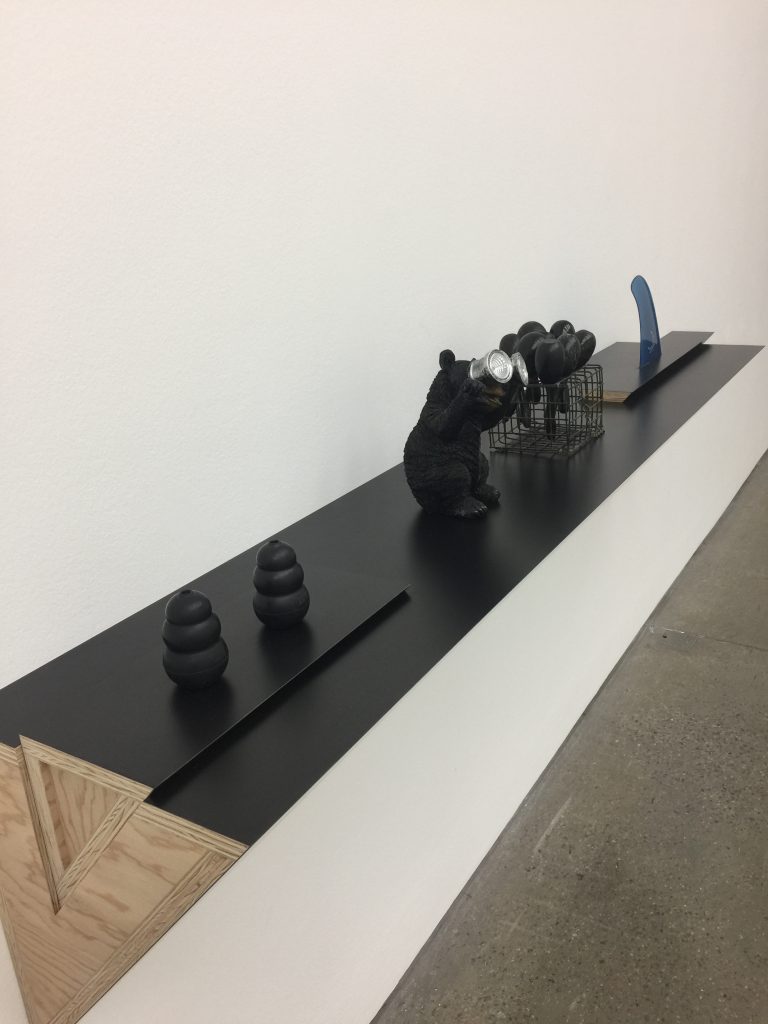
A ceramic vase may have a shinny green glaze that is beautiful and reflective but that glaze does not go from one wall to the other side. It is a glaze it is on top of something else but you don’t see that something else. With my shelf there is always one side that is always open and you can see the structure.

That’s something more than just ‘Look’ in terms of referencing, in fact the shelf angles are 90/50/40 degrees, they are always the same, the shelf can become bigger or smaller but the angles always remain the same. So the shelf has got this possibility of amplification and contraction. Which allows me to ‘put’ in a bigger or smaller object. It functions like an instrument or device. So this structural aspect that evolved through the work & the thinking becomes significant to the thinking of the work and the thinking of the object. It’s a smaller architecture unit that is used to access value.
Have you ever shown a shelf without an object on it?
No… The shelf without an object on it would be a very interesting object. Display #7 by the same token – the surfacing of the paradigm of minimal art from the 60’s defined a new way of focussing on things and made a relationship with things through that kind of dialectical debate that many artists participated with. The shelf comes out of the meaning of that paradigm. & it really takes you to a new dimension. Donald Judd talked about specific objects but he was talking about the specific structure of the object of the shelf, the specificity of the shelf the materials and things like that. By the 70’s I would say to myself ‘But Judd is talking about specific objects but all objects are specific. How do you address that?’
Try to engage what they do with each other.
What does an ‘Object being specific’ mean?
For Judd it meant something specific and he used the term before anyone else had. Judd was a thinker,writer,critic he wrote critically about ideas, it was a term he used about a specific focus in the practice of his work – specific for his objects – they became specific objects. The object is not relational art- its not social. It is specific and it’s an object – this is not sculpture – this is a specific object. Its interesting in terms of the concert of objects and objects within minimal art.
& today in the last ten years we have a branch of philosophy object oriented ontology – but in the 60’s we didn’t have a philosopher who said hey guys you are beginning to address the concept of object oriented ontology. Its interesting that they moved away from sculpture and art for defining what they did/created- the model that they gave us was completely radical.
They did it but it wasn’t until someone came up with a philosophy that they understood what they did?
I would say that I understood what they did. I came across object oriented ontology 4/5 years ago- a curator who engaged me to do a project began talking tome about it – Whats that then? (I asked)
You don’t know ! object oriented ontology- thats what your work is all about !!
So for the last 4 years I’ve got a philosophy that frames what I do. & I met Timothy Morton Professor and Rita Shea Guffey Chair in English at Rice University. Originally from Great Britain and a member of the object-oriented philosophy movement, Morton’s work explores the intersection of object-oriented thought and ecological studies. By chance I met him, he is now a major figure in the field and he has also written a text in my catalogue.
So these guys where touching on this in the 60’s but there was no philosophy at that time. But now with object oriented ontology and people like Timothy Morton people are writing about it. But only in the last two years have art writers been introducing the concepts to the art community. I met the curator he introduced me to it 4/5 years ago. I made the leap 30/40 years ago but they just didnt have the philosophy or language to talk about it properly they called it Kitsch etc.
I recognised in the minimal paradigm and Judd talking about specific objects that really branches into the questions: what are specific objects? Moving away from art and sculpture and calling them objects – Brilliant – but then What are objects? It’s not an art object, it’s not sculpture, what is so special about your object? For him he had his own terms, materials but I was What is it?
By the mid 70’s ten years after minimal art began to question – I began to question objects in the mid 70’s. I was literally taking the object and saying “Ok what are objects?” I didn’t transform them , I simply placed them on a shelf – that brings us to Display #7 and why it was important.
It was a work/concept that generated a new historical movement in contemporary art.
& then 30 years latter we have a philosophy about a hierarchy of objects that all objects are the same it’s value just depends on how they collide and so on.
You can see some of Haim Steinbach’s shelf works upstairs in his exhibition jaws at White Cube in Masons yard and downstairs you can see Display #15 – Design for a Yogurt Bar on until 20 January 2018 whitecube.com & Opening on the same day his London show closes is Haim Steinbach’s first solo exhibition in Israel in Jaffa at Magasin III Museum & Foundation for Contemporary Art’s new satellite space. More Info
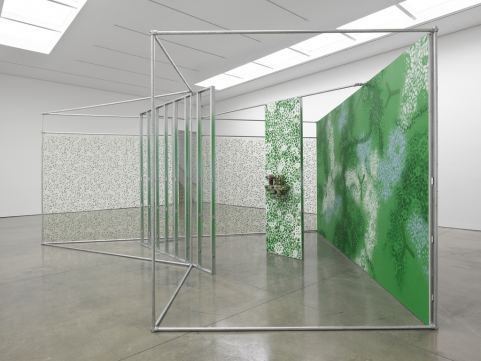
Display #15 – Design for a Yogurt Bar 1981 / 2017
Galvanised steel frame; aluminium studs; plasterboard; latex paint; spray paint; screen-printed PVC curtain; metal shower curtain rings; Shelf with Moroccan coffee pot, chair and potted flower
Dimensions variable Photo: White Cube (George Darrell)

